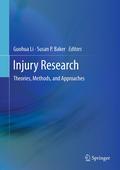
Injury is recognized as a major public health issue worldwide. In most countries, injury is the leading cause of death and disability for children and young adults age 1 to 39 years. Each year in the United States, injury claims about 170,000 lives and results in over 30 million emergency room visits and 2.5 million hospitalizations. Injury is medically defined as organ/tissue damages inflicted upon oneself or by an external agent either accidentally or deliberately. Injury encompasses the undesirable consequences of a wide array of events, such as motor vehicle crashes, poisoning, burns, falls, and drowning, medical error, adverse effects of drugs, suicide and homicide. The past two decades have witnessed a remarkable growth in injury research, both in scope and in depth. To address the tremendous health burden of injury morbidity and mortalityat the global level, the World Health Organization in 2000 created the Department of Injury and Violence Prevention, which has produced several influentialreports on violence, traffic injury, and childhood injury. The biennial WorldConference on Injury Control and Safety Promotion attracts a large international audience and has been successfully convened nine times in different countries. In the United States, the National Center for Injury Prevention and Control became an independent program of the federal Centers for Disease Preventionand Control in 1997. Since then, each state health department has created an office in charge of injury prevention activities and over a dozen universitieshave established injury control research centers. This volume will fill an important gap in the scientific literature by providing a comprehensive and up-to-date reference resource to researchers, practitioners, and students working on different aspects of the injury problem and in different practice settings and academic fields. First text focusing on contemporary injury research methods, illustrated by real examples. Covers recent developments in theories, methods, concepts, and techniques in injury research. Includes quantitative, qualitative, experimental, and observational methods from multiple disciplines. INDICE: Part I. Injury Surveillance. Chapter 1. Surveillance of Injury Mortality. Chapter 2. Surveillance of Injury Morbidity. Chapter 3. Injury Surveillance in Special Populations. Chapter 4. Surveillance of Traumatic Brain Injury. Part II. Injury Causation.- Chapter 5. Forensic Patholoy. Chapter 6.Determination of Injury Mechanisms. Chapter 7. Ergonomics. Chapter 8. Experimental Methods. Chapter 9. Epidemiologic Methods. Chapter 10. Qualitative Methods. Chapter 11. Environmental Determinants. Chapter 12. Behavioral Determinants. Part III. Injury Outcome. Chapter 13. Injury Profiling. Chapter 14. Injury SeverityScaling. Chapter 15. Triage. Chapter 16. Prediction Rules. Chapter 17. Biomarkers of Traumatic Injuries. Chapter 18. Functional Outcomes. Chapter 19. Injury Costing Frameworks. Part IV. Analytical Approaches. Chapter 20. Statistical Considerations. Chapter 21. Video Data Analysis. Chapter 22. Age-Period-CohortModeling. Chapter 23. Multilevel Modeling. Chapter 24. Geographic InformationSystems. Chapter 25. Spatial Regression. Chapter 26. Social Network Analysis.Part V. Approaches to Injury Reduction. Chapter 27. Legal Approach. Chapter 28. Public Policy. Chapter 29. Environmental Approach. Chapter 30. Technological Approach. Chapter 31. Behavioral Approach. Chapter 32. EMS and Trauma Systems. Chapter 33. Systems Approach to Patient Safety. Chapter 34. Intervention in Low-Income Countries. Chapter 35. Implementing and Evaluating Interventions.Chapter 36. Economic Evaluation of Interventions.
- ISBN: 978-1-4614-1598-5
- Editorial: Springer US
- Encuadernacion: Cartoné
- Páginas: 721
- Fecha Publicación: 28/01/2012
- Nº Volúmenes: 1
- Idioma: Inglés
